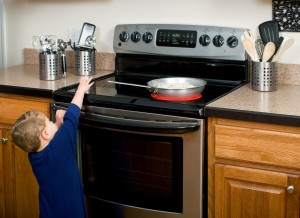2/8/17 blog post
beware of burns
Toddlers love to be where mom is. So that means all too often they are right underfoot while you are curling your hair, cooking or even running on the treadmill. Unfortunately these become likely scenarios for your child to end up with a burn. 
As part of burn awareness week, the American Burn Association and Dayton Children’s Hospital want to alert you to the danger. Any hot appliance, such as a curling or flat iron for your hair, or an iron for your clothes is a burn risk when a curious child yanks on the cord. A moving treadmill belt only takes seconds to create a friction burn. And a pot handle at the edge of a stove may be too much temptation for a little one to resist grabbing.
The average burn patient who comes to Dayton Children’s Hospital is around 5 years old. In fact, a child younger than 5 years old is almost two and a half times more likely to be the victim of a burn that requires emergency treatment, but no child is immune to the dangers.
Teens can be especially at risk because they are more active in the kitchen, cooking and serving themselves. “We see a lot of burns from hot chocolate,” says Linda Hollen, FNP-C, burn clinic advanced practice nurse at Dayton Children’s. “Ramen noodles and oatmeal are also trouble foods. Many times children are handling these items in Styrofoam cups and hot water or liquid may spill onto their hands or laps, leading to severe burns.”
“Children have a greater risk of getting deeper and more serious burns because they have thinner skin than adults,” says David P. Meagher, MD, medical director for burn care at Dayton Children’s. “Also, because children are smaller, a greater proportion of their total body surface is susceptible to being burned.”
Another area of concern for burns in children are heaters or fireplaces. Just a few years ago, regulations went into effect to make fireplace glass fronts safer to the touch. However for anyone who has a fireplace older than a year or two, that glass or metal front can get dangerously hot. A simple bump can leave a nasty burn.
The bathtub is also another danger zone. Parents should set their water heater temperature to no higher than 120 degrees, or just below the medium setting. Never put a child in water that you have not tested the temperature of first. Finally, have your child sit at the opposite end of the tub from the faucet.
With a little preparation and a lot of supervision, you can help protect your children from a variety of burn hazards.

